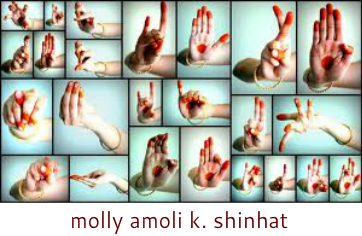Emerging from the shadows
|
Barry Ace,
|
"I dreamed of being a warrior". Dressed up as our beloved warrior princess, Xena, in her imaginary landscape, native photographer Rosalie Favell switches the chakra for a dream-catcher. A twilit star-smattered sky heightens her skin-tones and the glamour quotient. Morphed onto the classic arms akimbo Xena pose, her quizzical half-smile welcomes the viewer to a dream come true, photographically anyway. Looking so gorgeously warrior-like, thankfully, reckoning with Favell encompasses dealing with her strong sense of humour too.
Part of the Plain(s) Warrior series, it's one of six massive images (about 32" x 50"). Using Xena and other pop culture icons, Dorothy in Kansas for example, Favell slashes through the cobwebs of the anthropologically-induced photographically-produced web of images of native women. If identified at all, a woman was "the wife of" or simply "the squaw". Anthropologists' primary interest was men.
Entitled Perspectives from the Urban Frontier, five native artist-photographers complete this section. Greg Hill'sPlastic Indians (from Outer Space) addresses his preoccupations with plastic "Indian" figures. As he explains, the "Made in China" label and "grotesque facial features" led him to believe that somehow his childhood friends had "confused alien invaders with me". Like Favell, he makes masterful use of new digital imaging technologies, photographically reproducing the figures in bold, over-saturated lurid colours, like bright turquoise on a rich purple. The hyper-leaps in colour temperature mimic the distortions of native identities and histories—striking war-like poses, the figures frequently bear tomahawks and the stereotypical feathered headdress.
Through the anthropologist's camera, a substantial series of archival photographs from the early 20th century of First Peoples makes up the exhibition's other section. Culled from the collections of the Geological Survey of Canada, now the Museum of Civilization, it includes short biographies of the photographer-anthropologists. Consisting of "field portraits", the photographers worked with large-format cameras and glass negatives. For each shot, a glass plate (probably larger than 8" x 10") coated with photosensitive emulsion was loaded into the camera.
With no retouching, the visual rifts between this section and the contemporary work take on the feel of a continental divide - not that it needed any help. The carpet laid over native struggles around identity gets rolled up and stuck in the trashcan of history but not without retaining some precious threads. Many of the archival portraits are stunningly beautiful, particularly the work by Harlan Ingersoll Smith (1872-1940). Unlike his brethren, Smith gave sitters copies, and many gaze comfortably straight into the lens. Still, native photographer-curator Jeff Thomas' attempt to recast the anthropologists' view as somehow neutral surely stretches the facts just a little. Anthropology has power-relationships around racial constructs built into it by its very definition—it's the reason these images were made at all.
Thomas has carefully created a fantastic set of imagery, using the present and the past, a visual disturbance where each image could be traced to an ancestor in its sister section. Fearlessly, he's set out not only to venture a few questions but also to attempt a minor revolution—put smiles on viewers' faces in a museum.
Published in The Ottawa Xpress, 2000
Part of the Plain(s) Warrior series, it's one of six massive images (about 32" x 50"). Using Xena and other pop culture icons, Dorothy in Kansas for example, Favell slashes through the cobwebs of the anthropologically-induced photographically-produced web of images of native women. If identified at all, a woman was "the wife of" or simply "the squaw". Anthropologists' primary interest was men.
Entitled Perspectives from the Urban Frontier, five native artist-photographers complete this section. Greg Hill'sPlastic Indians (from Outer Space) addresses his preoccupations with plastic "Indian" figures. As he explains, the "Made in China" label and "grotesque facial features" led him to believe that somehow his childhood friends had "confused alien invaders with me". Like Favell, he makes masterful use of new digital imaging technologies, photographically reproducing the figures in bold, over-saturated lurid colours, like bright turquoise on a rich purple. The hyper-leaps in colour temperature mimic the distortions of native identities and histories—striking war-like poses, the figures frequently bear tomahawks and the stereotypical feathered headdress.
Through the anthropologist's camera, a substantial series of archival photographs from the early 20th century of First Peoples makes up the exhibition's other section. Culled from the collections of the Geological Survey of Canada, now the Museum of Civilization, it includes short biographies of the photographer-anthropologists. Consisting of "field portraits", the photographers worked with large-format cameras and glass negatives. For each shot, a glass plate (probably larger than 8" x 10") coated with photosensitive emulsion was loaded into the camera.
With no retouching, the visual rifts between this section and the contemporary work take on the feel of a continental divide - not that it needed any help. The carpet laid over native struggles around identity gets rolled up and stuck in the trashcan of history but not without retaining some precious threads. Many of the archival portraits are stunningly beautiful, particularly the work by Harlan Ingersoll Smith (1872-1940). Unlike his brethren, Smith gave sitters copies, and many gaze comfortably straight into the lens. Still, native photographer-curator Jeff Thomas' attempt to recast the anthropologists' view as somehow neutral surely stretches the facts just a little. Anthropology has power-relationships around racial constructs built into it by its very definition—it's the reason these images were made at all.
Thomas has carefully created a fantastic set of imagery, using the present and the past, a visual disturbance where each image could be traced to an ancestor in its sister section. Fearlessly, he's set out not only to venture a few questions but also to attempt a minor revolution—put smiles on viewers' faces in a museum.
Published in The Ottawa Xpress, 2000

